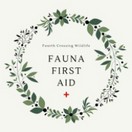Short Term Care

Short Term Care for Parrots
It
is important to remember that an injured, sick or orphaned parrot, as with any
wild animal, will be stressed when caught. It is very important that
it is kept in a dark, quiet place, away from children and family pets.
If
it is an adult or juvenile bird put it in a small box, such as a shoe box, so
that it cannot flap its wings. Put it in a dark, quiet place, and leave
it alone for at least an hour, so that it can "de-stress".
If
it is a baby bird with no feathers, or just feathered, then it needs to be kept
warm. Place the bird in an artificial nest, eg: a small bowl lined with
paper towel. Place a lamp over the nest with a low power
(around 25 watt) coloured light globe, eg: a green
or red globe. If a coloured globe is not readily available, use a pearl
or frosted globe.
Pin a tea towel around the lamp so that it hangs down and encloses the nest, this
will hold the warmth in. The temperature needs to be around 33o to
37o Celsius - no higher. If you are putting the nest in an enclosed
box you will need to put a small cup of water inside the box to keep the air humid
- dry air will dehydrate the bird. Place a screen over the water cup, for
example fly screen or netting, so that the bird cannot get into the cup and drown.
Do
not feed any wild animal for at least a few hours after rescue - they need to
have their stress levels reduced and too much human contact can send them
into shock. Additionally, it is very important that you do not feed a cold
animal as any food will not be digested properly and the bird may die. If the
rescued bird is cold you will need to warm it very slowly - if you warm the bird
too quickly it may also die from heat-stress related complications. An animal
that is badly injured or sick will not want to eat. If this is the case,
just leave the bird in the box until an experienced carer can collect it, or take
it to a veterinarian.
Food
for an adult parrot can include fruit, such as apple or pear, fresh grass and
grass seeds, and commercial bird seed for parrots. Do not attempt to feed
the bird by hand, leave the food in the box and it will eat when it is ready.
Make sure that the bird has access to fresh water.
A
baby feather-less or just feathered parrot can be fed rolled oats that have been
crushed well, mixed with Farex (but as emergency food only - to much of this mixture
will kill them, as it has little nutritional value). Alternatively, you
can use commercial parrot hand-rearing mix which is available at most produce
shops. The mixture should not be watery, but should have the consistency of mushy
weatbix. A too watery mixture can get into the windpipe and drown the bird.
Feed the bird by placing a small spoon, such as a teaspoon, at the edge of its
beak, the bird will 'guzzle' the food off the spoon. The correct mixture
should slide off the spoon easily. For less messy feeding curl the
spoon up at both sides. Feed the bird until its crop (the 'sac' located
at the bottom of it's neck) is nearly full, make sure to leave a small space.
Do not feed the bird again until the crop
has completely emptied. Do not re-use
food, any food remaining from a feed should be discarded.
Just
remember to use your common sense when caring for a parrot. You are caring
for a wild animal, it is not a pet.
Keep pets, family and friends away from
the animal at all times.



